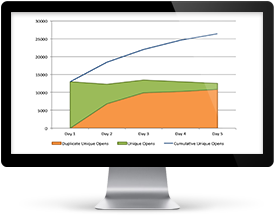Email Send Frequency – What’s Your ROI Sweet Spot?
When it comes to email send frequency, is more better? Here, we discuss how to determine your email send frequency sweet spot to best optimize your email-marketing return on investment (ROI).
Finding the Right Email Send Frequency Maximizes Your Opportunity to Engage and Convert
Determining the optimum number of emails to send to your subscribers can be a daunting challenge. Undermailing increases your chances of missing out on sales from subscribers who are ready to make a purchase. Plus, undermailing also results in fewer emails – and impressions – to help keep you top of mind with subscribers.
On the other hand, overmailing can lead to more people ignoring your emails, unsubscribing from your email list, or – worse – marking your emails as spam. In addition to hurting your brand’s reputation, overmailing can also have a negative impact on your email deliverability.
Large-Scale Study Looks at Send Frequency & Subscriber Engagement
So what is the ideal number of emails a company should send to maximize response without resulting in more complaints? To help answer that question, the data solutions provider, Return Path, studied the subscriber engagement of more than 199 million messages delivered to more than 600,000 email inboxes between December 2014 and February 2015.
For this study, ReturnPath divided subscribers into three types of email accounts:
- Primary – This group of subscribers demonstrated a high degree of inbox activity, including opening, deleting, and moving email messages. These subscribers accounted for 24% of users, 83% of reads, and 50% of complaints.
- Secondary – This group of subscribers received a large number of promotional and transactional emails in their inboxes, but few personal messages. They were less engaged than the Primary group and accounted for 67% of users, 16% of reads, and 49% of complaints.
- Dead – This group of subscribers showed very little engagement, making up only 9% of users, 1% of reads, and 1% of complaints.
The Primary subscribers in this study proved to be the most valuable. Although they were only 24% of all users studied, Primary subscribers accounted for 83% of total emails read. This group of highly active email users tolerated up to five emails per week from a sender before the number of complaints offset the number of emails read. Keep in mind that once a user complains (marks an email as spam), email service providers typically stop delivering that sender’s email to the individual’s inbox, which ends the relationship between sender and subscriber.
Dramatic Results Obtained in FulcrumTech’s Email Send Frequency Test
At FulcrumTech, we recently conducted a frequency test for a client to determine whether 1) a higher send frequency would increase engagement, and 2) if the additional revenue would outweigh the cost of list saturation. This test involved sending the same email to the same list of subscribers for five consecutive days
In this test, we measured open reach (the cumulative number of unique individuals who open an email throughout the campaign) and subscription sales. The results were dramatic:
- Open reach increased by 103%
- The number of paid subscription sales increased by 269%.

In this case, increasing the email send frequency helped to drive sales growth for our client. When increasing your email send frequency, however, be sure to keep a close eye on your unsubscribe rates and spam complaints.
Determining Your Email Send Frequency Sweet Spot
So, how many emails is just the right number to maximize subscriber response without causing an increase in unsubscribe and spam complaint rates? That number varies based on several variables, including your type of business and your target audience’s expectations. So, setting up optimization tests to determine your send frequency sweet spot is the best way to find that number.
In addition to sending frequency optimization tests, here are some other ways to ensure you’re sending the optimum number of emails:
- Set up an email preference center to give customers a say about how many emails they get from your company from the start.
- Continually measure and track your list activity (e.g., open, click, and conversion rates), as well as unsubscribe rates and spam complaints, relative to the number of emails you send.
- Create different segments based on subscriber activity (similar to the segments described in the Return Path study above). Then, use the degree of subscriber engagement to test and determine the optimum send frequency for each segment. There are many testing scenarios of frequency that should be considered. For example, you can test whether your performance metrics improve by:
- Sending more emails to subscribers who frequently open and convert
- Sending fewer emails to less-engaged subscribers
- Sending more emails to less-engaged subscribers to reengage them.
- Consider the long-term impact of sending emails at a higher frequency. In our test described above, for example, increased email send frequency generated more subscriptions. But that doesn’t mean your company should simply start mailing consistently at that frequency, as it could burn out your list over time.
Need help with optimizing your email send frequency to maximize your email-marketing ROI? Contact the team of experts at FulcrumTech and we’ll help find your email send frequency sweet spot for sending more and selling more.
Other Articles You Might Like
- 6 Super Ways to Keep Your Subscribers Engaged and Happy
- What Time of Day Should You Send Your Email Campaigns?
- How FulcrumTech Helps Clients Achieve Outstanding Email-Marketing Results with Automation & Real-Time Testing & Optimization
- Effective Email Preference Centers Help Keep Subscribers Active and Engaged
- Email-Marketing Optimization — 7 Steps to Effective A/B Split Testing